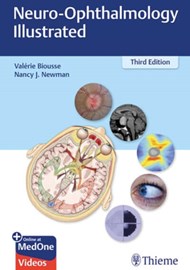I have a slight hatred of neuro-ophthalmology. It seems bizarre and foreign to me and I know I’m not the only one who groans at getting a patient with diplopia or a non-specific headache. So I will always be pretty excited at getting any textbook which helps me better understand this subspeciality.
When I was flicking through this book I have to say, I was impressed. These guys really mean it when they say it is neuro-ophthalmology ‘illustrated’. The vast majority of the pages seemed to be figures or diagrams or flow charts (If you’ve read my review of Clinical Pathways in Neuro-ophthalmology you’ll know I have a bit of a thing for flow charts.)
It takes you by the hand and walks you through the neuro-ophthalmic examination, visual fields, the dreaded diplopia and so much more. Overall there’s 21 chapters and if you’re wondering if it covers the things you want to read up on, the chapters are:
- The neuro-ophthalmic examination
- Funduscopic examination
- Visual fields
- Ancillary testing commonly used in neuro-ophthalmology
- Visual loss: an overview
- Transient visual loss
- Retinal vascular diseases
- Optic neuropathies
- Disc oedema
- Disorders of higher cortical function
- Abnormal visual perceptions: hallucinations and illusions
- The pupil
- Diplopia
- Orbital syndrome
- Cavernous sinus and orbital vascular disorders
- Nystagmus and other ocular oscillations
- Disorders of the eyelid
- Nonorganic neuro-ophthalmic symptoms and signs
- Diagnosis of headache and facial pain
- Disorders commonly encountered in neuro-ophthalmology
- The visually impaired patient
I think it’s fair to say it’s very comprehensive. You might look at the list and think it may be a tad more than you’re looking for but when you read the text, it feels like it goes into just the right amount of depth so you walk away feeling like you really understand that section without feeling overloaded.
There have been two previous editions, and they aimed to improve this edition by adding access to over 50 videos. It’s a Thieme textbook so you log into MedOne and enter the access code and away you go. When it comes to assessing patients with neuro-ophthalmic conditions, these kinds of videos are invaluable.
Again, I’d probably recommend flicking through the ebook instead of the actual hard copy. The textbook itself is about A5 size, and because there are so many figures you might find yourself flicking quite a few pages ahead to get to the figure referenced in the section you’ve just read. With the e-book the figures are right below the paragraph it’s been referenced in and the images are so much larger.
I think it’s a great handbook which is very accessible to both junior and senior trainees in both ophthalmology and neuro-ophthalmology. If you’re fed up of neuro-ophthalmology books that are just walls of text and you want to actually enjoy studying it, definitely give this book a try.




